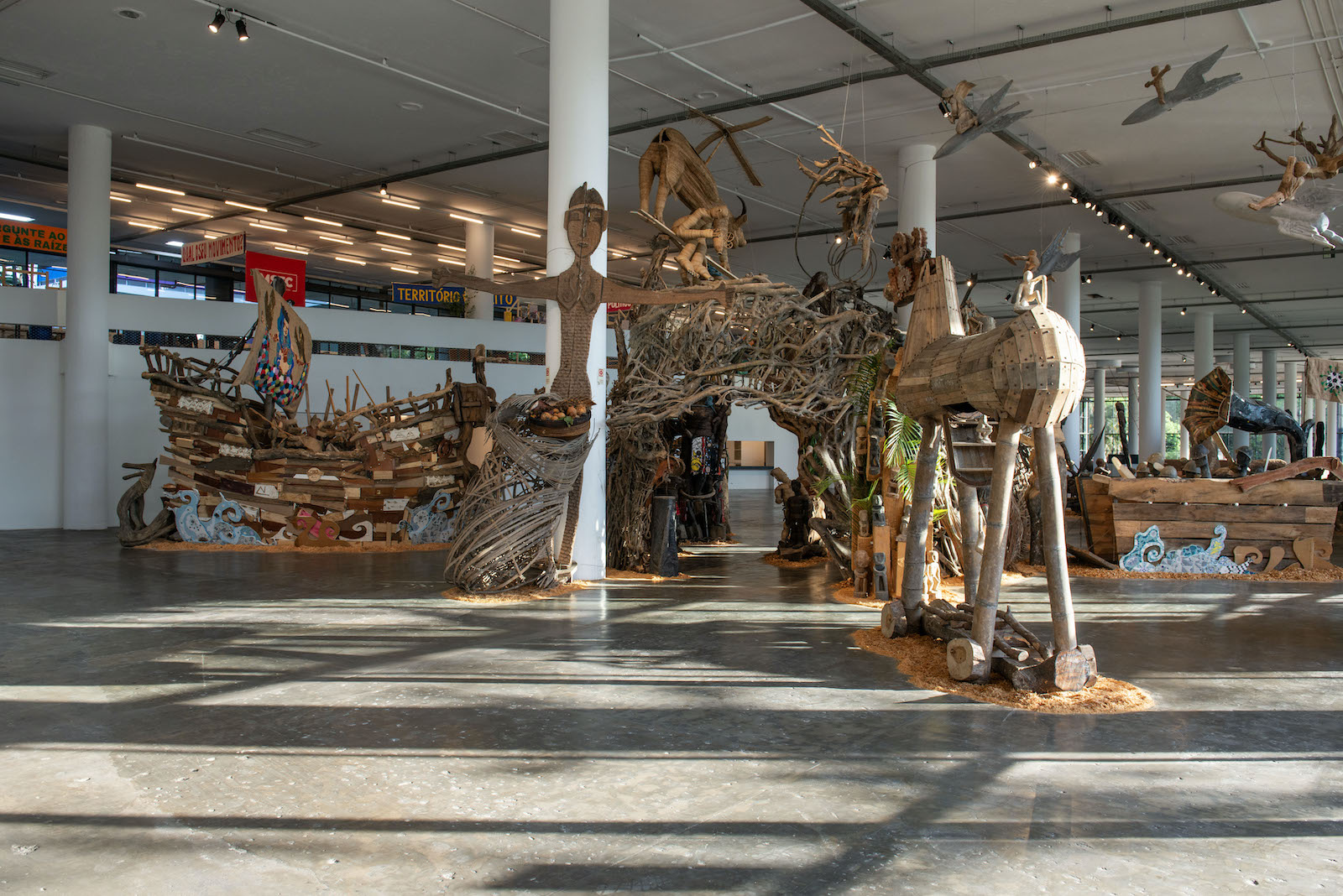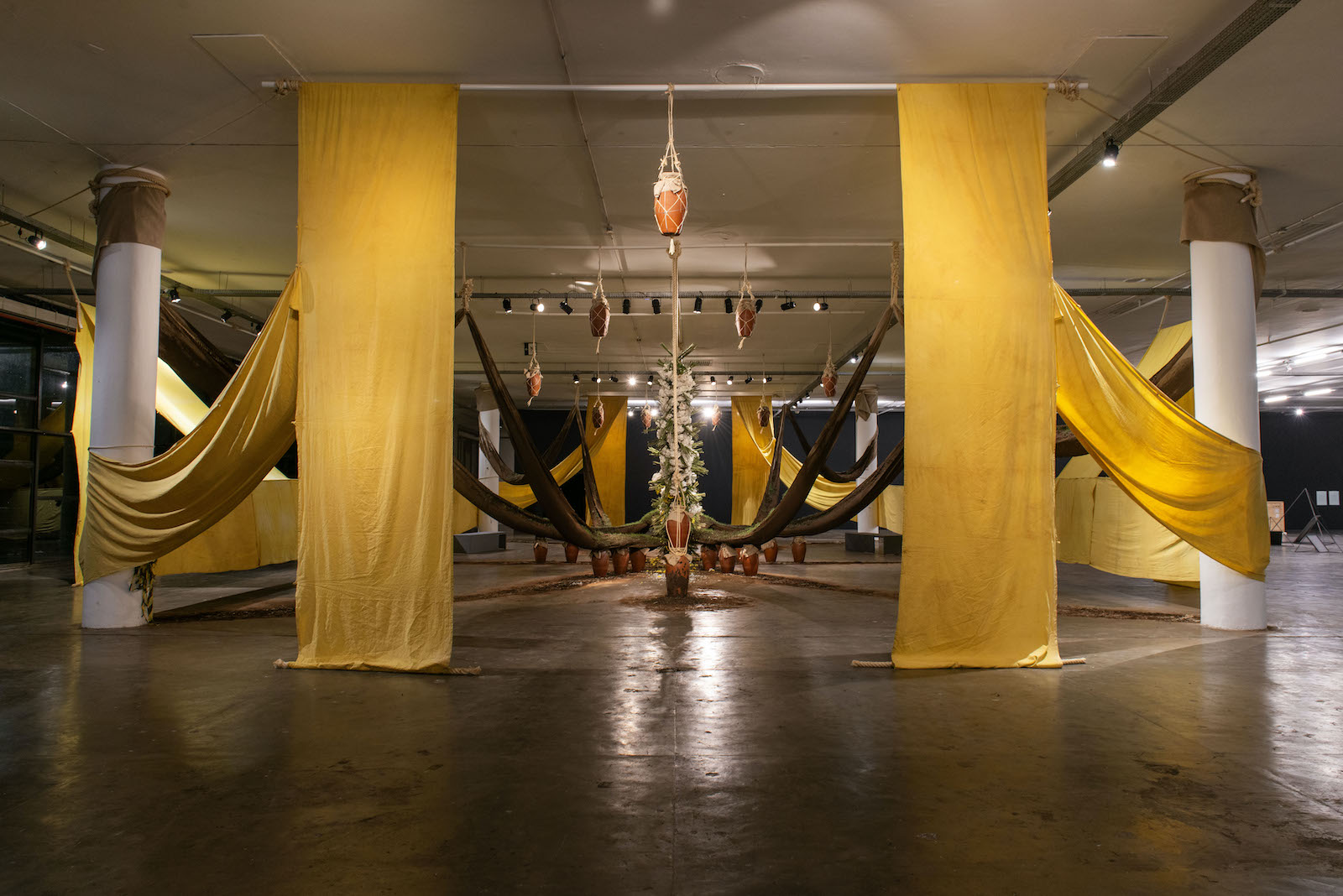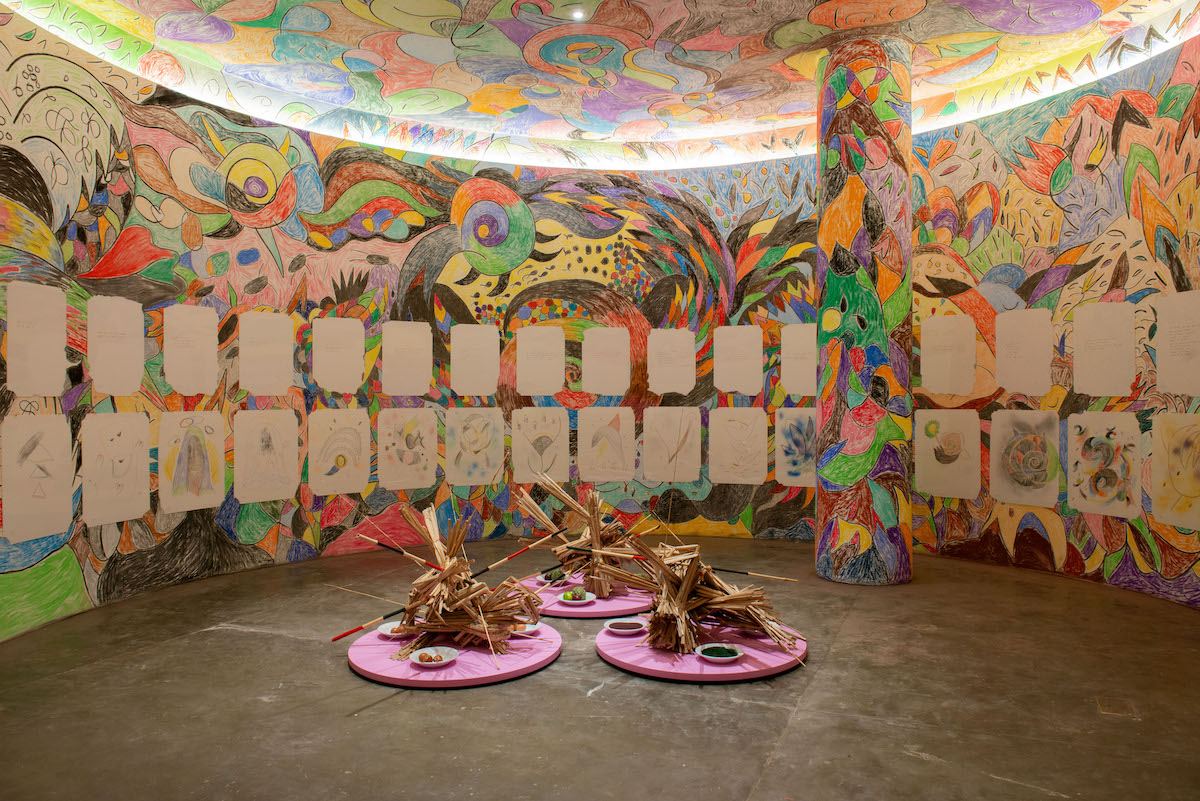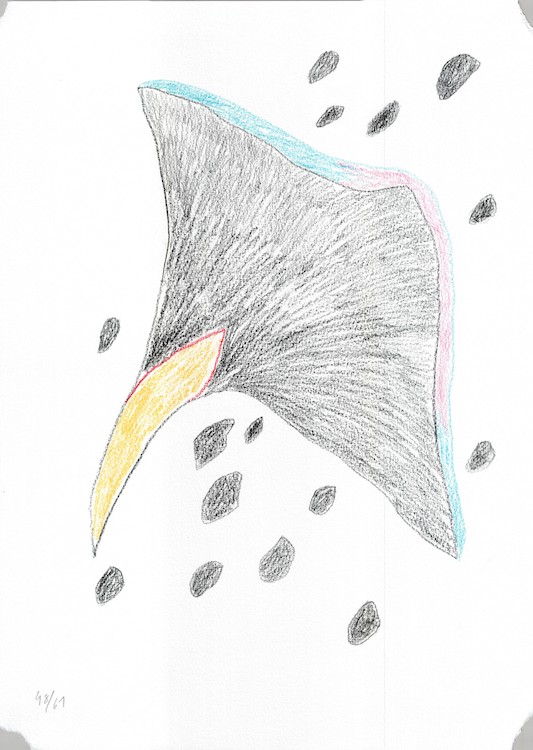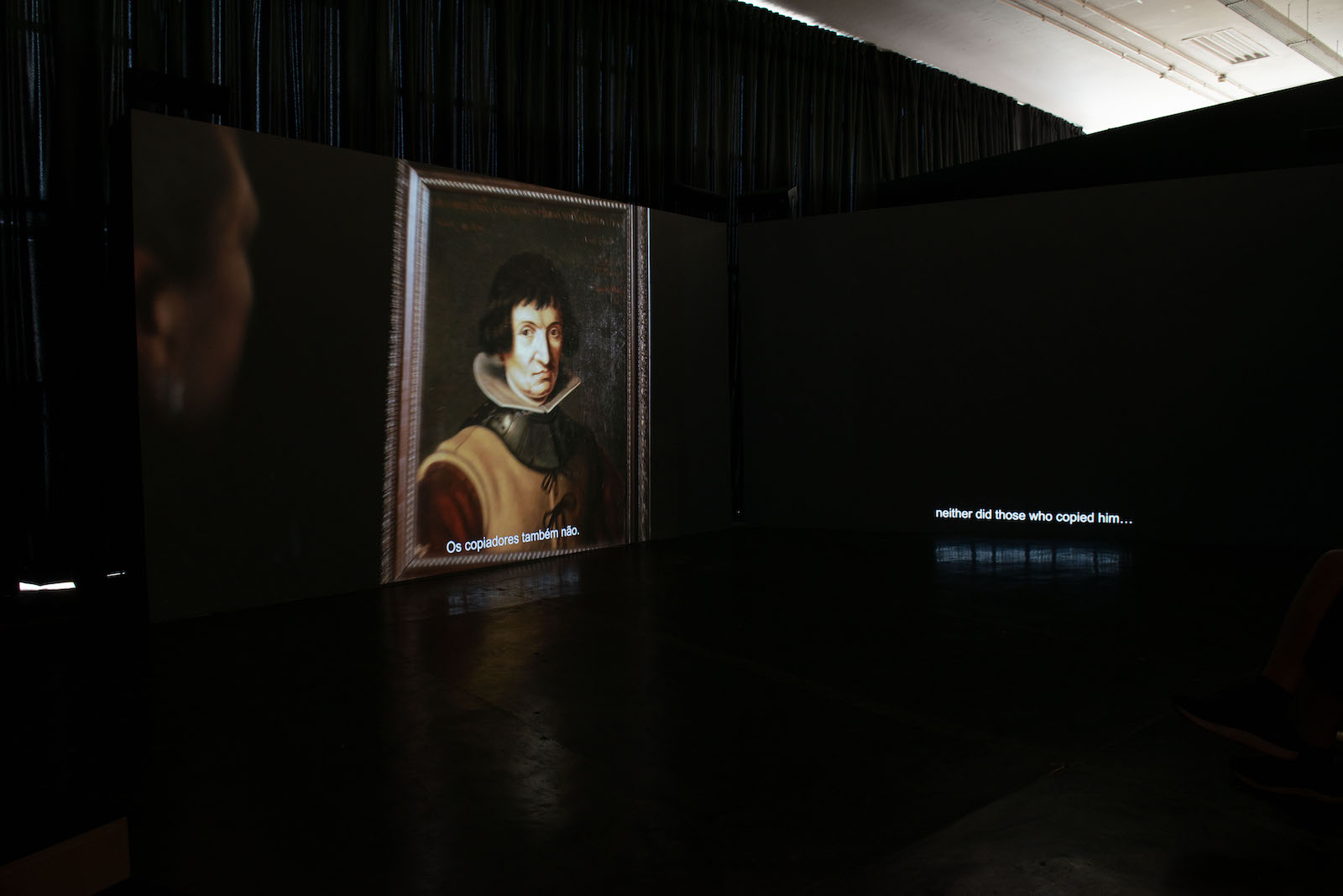Choreographies of the Impossible, the 35th Bienal de São Paulo
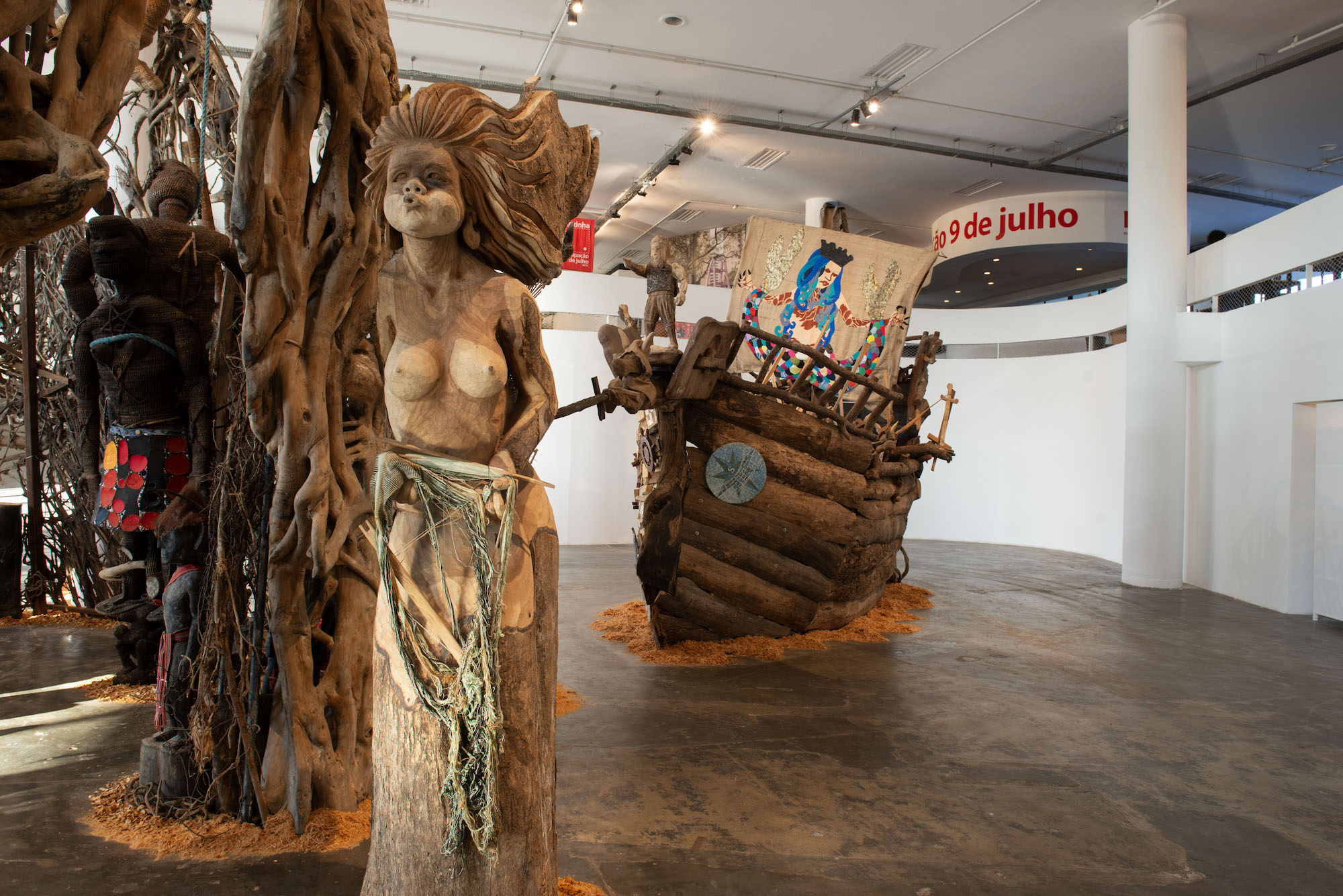
Kidlat Tahimik, Killing Us Softly … with their SPAMS … (Songs, Prayers, Alphabets, Myths,Superheroes …), installation view, 2023 [courtesy of the artist and Fundação Bienal de SãoPaolo, São Paolo]
Share:
Inhabian, Filipina goddess of wind, blows air up a wooden Marilyn Monroe’s skirt. Mickey Mouse dons a Darth Vader-style helmet, and wields a camera that doubles as a chainsaw—documenting his castration of the rainforest. Kidlat Tahimik’s installation Killing Us Softly … with their SPAMS … (Songs, Prayers, Alphabets, Myths, Superheroes …) (2023) connects the colonialist encounter of European ships descending on the Global South to entertainment invaders from the last hundred years. Here, teeny Spider-Men rappel from the belly of a Trojan Horse and storm the wooden gates of an indigenous village. A villager rocks a loincloth fashioned from out-of-date cell phones, a reminder of cultures shifting, of the North selling the South its technological hand-me-downs.
Kidlat Tahimik, “Killing Us Softly … with their SPAMS … (Songs, Prayers, Alphabets, Myths, Superheroes …)”, installation view, 2023 [photo: Levi Funan; courtesy of the artist and Fundação Bienal de São Paolo, São Paolo]
Tahimik and a group of Filipino collaborators carved the battle sequence from wood, Mnot grand Euro marble, and its position on the first floor of the 35th Bienal de São Paulo primes the viewer to witness four floors of the cacophony colonialism has wrought. By featuring Captain America (nationalist super-soldier monster) and Igpupiara (a Tupi sea monster with breasts and a mustache who supposedly terrorized Magellan off the coast of Brazil in the 1560s), Tahimik draws attention to the colonial project as a collision with heroes who are also villains. Invasions occurred, cultures tangled—no going back now. Igpupiara’s slippery subject position (Is she a hot mermaid? A sinister queer-coded bad guy grooming and devouring innocent conquistadors? A cultural construct built from everyone’s fear of the unknown?) can remind us that confrontation is never as simple as colonizer vs. colonized, male vs. female, hero vs. villain. Such systems as gender and colonialism aren’t static—they require action. You’re born into a circumstance, then you start to move.
Call it a choreography, one that gives name to the biennial, curated by a nonhierarchical collective (Diane Lima, Grada Kilomba, Hélio Menezes, and Manuel Borja-Villel). These Choreographies of the Impossible reference the starting point of being born conquered, or existing outside gender lines, which can code as “impossible” positions. Within our given geopolitical status/country of origin/race/name/gender, how do we move? And perhaps, more importantly, where can we move to: physically, intellectually, emotionally, spiritually?
Daniel Lie, Others, installation view, 2023 [photo: Levi Funan; courtesy of the artist and Fundação Bienal de São Paolo, São Paolo]
For some, movement means letting death in and moving through it. Nonbinary artist Daniel Lie’s installation Outres (2023), which foregrounds the fungal process of turning death into life, also requires human action—water twice daily. Healing colonial losses is an active task. Lie suspends dried chrysanthemums from the ceiling—angels watching over freshly sprouting greens. A site of the funerary and of life beginning. It also smells. Could the most effective way to feel change move—decomposing and recomposing in real time—be inside your own nose?
Growing can also come from choreographed regression. Upon walking into Black trans artist Tadáskía’s cylindrical room, it may appear, at first, as if a skilled kindergartener were let loose with a pack of crayons. Dry pastel covers its every inch, including the ceiling, with swirls and squiggles. The room’s short poems nod to “saints, witches, fairies,” and their simplicity, after a few moments, reads as wise: “in the dream I meet all the mystical birds / of the other worlds / together / at the same time / we’re black old and young.” Maybe equating wisdom with mastery is where the West went wrong. The old adage used to knock abstract art comes to mind: “My kid can do that.” Maybe they can, and maybe you should, too. Tadáskía doesn’t perceive the child as a static identity, as naive or innocent or in need of preservation, but as a place from which to move, to approach, to act. She colored most of the walls with her eyes closed, and if your kid can do that, there are reasons you can’t: the rules you’ve accumulated about what’s “good” and “bad,” what “black” and “white” mean to you, what “male” and “female” roles give way to, that hold you in place. Mastery might mean accessing many temporal points at once, moving seamlessly between them, a natural experience of many trans people, whose puberties, adulthoods, and deaths grow at overlapping and unexpected rates.
Tadáskía, Ave preta mística [Mystical Black Bird], installation view, 2022 [photo: Levi Funan; courtesy of the artist and Fundação Bienal de São Paolo, São Paolo]
Deep in the exhibition’s top floor, the curators include a painting of Doña Catalina de Erauso by Juan Van der Hamen y León from 1626, the first known trans person depicted in a European oil painting. Erauso, assigned female at birth in 1592, ran away from a Spanish nunnery, went by Antonio and other male names, and lived a life of military exploits and adventure in the Spanish colonies, from Venezuela to Chile, including massacring members of the Mapuche tribe. Yes, one can act queerly and actively colonize. For juxtaposition, next to Erauso’s portrait sits a handwritten letter from 1591, the first documentation of a trans woman in Brazil. The letter, which mentions Xica Manicongo, an enslaved shoemaker, is a complaint filed by a concerned Portuguese citizen about a Black “man” who “uses the role of female” and who refuses to wear “the man’s clothes given to him by his lord.” Placing Manicongo and Erauso side by side showcases the disparity in possibility, how dependent movement can be upon one’s gender and colonial origin.
Cabello/Carceller’s video Una voz para Erauso. Un epílogo para un tiempo trans [A Voice for Erauso. An Epilogue for a Trans Time] (2021–2023—and perhaps the Biennial itself—reckons with how far we have and haven’t come since Erauso sat for that portrait. “Freedom is often found elsewhere,” says one of the video’s nonbinary performers, who often address the painting directly, as if Erauso is still present. Yes, he found his gender freedom in the Global South, but at what cost? When I move from one gender to another, from one country to another, what violence do I carry with me? Like Kidlat Tahimik’s piece, the Biennial’s curators pause the battle scene choreography of globalization just long enough to give the viewer perspective. The exhibition provides opportunities to zoom in on the details as well as to step back and behold the absurd full picture. Pausing allows introspection. Colonialism has typecast you.
Tadáskía, Ave preta mística [Mystical Black Bird], installation detail, Pencil, Paper, 2022 [courtesy of the artist and Fundação Bienal de São Paolo, São Paolo]
Cabello/Carceller, A Voice for Erauso. Epilogue for a Trans Time, installation view, 2021-23 [photo: Levi Funan; courtesy of the artists and Fundação Bienal de São Paolo, São Paolo]
Patty Gone is a performer, poet, artist, and scholar. She is the author of Love Life (Mount Analogue, 2019) and her writing has appeared in publications including The Believer, Hyperallergic, Howlr
